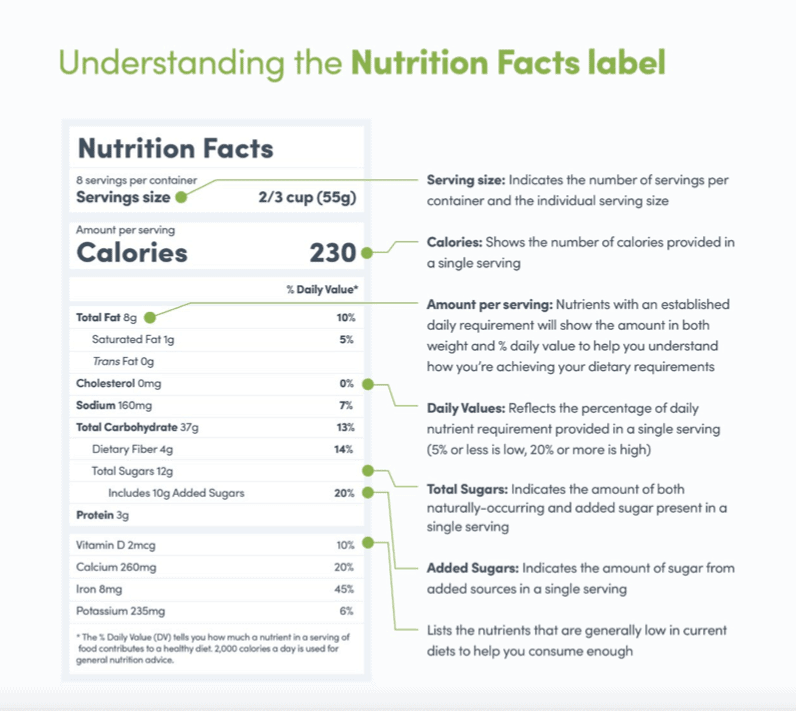
Benefits of counting macros
Though studies have traditionally focused on how the overall intake of calories affects our health, other recent research demonstrates that the ratio of macronutrients (carbohydrates:fats:proteins) can influence cardiometabolic health, body composition, and longevity. (9)(17)Cardiometabolic health
Certain macronutrient ratios may improve cardiovascular and metabolic health. For example, the DASH diet (Dietary Approaches to Stop Hypertension), which was developed as a method to lower blood pressure and improve cardiovascular health, recommends a low to moderate-fat approach, with an emphasis on lean proteins and fiber-rich carbohydrates (e.g., fruits, vegetables, whole grains). (3) Moderate to low-carbohydrate diets are commonly recommended for individuals with diabetes or prediabetes as they may help regulate blood glucose (sugar) and blood lipid levels, as well as prevent or mitigate the risk of diabetic complications. (6)Body composition and weight management
Counting macros is a popular method for weight loss and weight management. Research has shown that certain dietary patterns and macronutrient distributions can help individuals reach their goals. For example, low-fat diets may be beneficial for modest, sustained weight loss, whereas high-fat, low-carbohydrate diets may produce faster, more significant weight loss results. (7)(10) High-protein foods and diets are generally more satiating, helping you feel fuller for longer after a meal and thus preventing overeating. (16) Furthemore, several studies have noted that consistent dietary intake tracking helps participants stay on track and increases the likelihood that they will reach their weight goals. (2)(8) Macro counting is also used by many athletes and individuals attempting to gain muscle mass or boost athletic performance. This may include adjusting macronutrient ratios to increase protein or carbohydrates, depending on their fitness and body composition goals. (11)(21)Longevity
Some research suggests that macronutrient distribution plays a more significant role in longevity than does total caloric intake, suggesting that what you eat may be more important than how much you eat. (18) Although extensive evidence exists to suggest the importance of high protein intake in aging adults, (1) conflicting research proposes that a low-protein, high-carbohydrate diet may promote longevity. Residents of the Japanese island of Okinawa, who are among the longest-living people in the world, follow this type of dietary pattern, consuming approximately 85% and 9% of their total calories from carbohydrates and protein, respectively. (12) Unlike many North Americans, Okinawans and other Asian populations eat an abundance of vegetables and other high-fiber foods as their main carbohydrate sources. (19)(20) Diets high in fiber have been shown to contribute to lower risk of certain chronic conditions, including cardiovascular disease, type 2 diabetes, and cancer. (5)
How to count macros
The steps to calculating your macronutrient intake are outlined below.Step 1: Determine your caloric needs
Your age, sex, weight, height, and activity level all play a role in determining optimal macronutrient ratios to maintain a healthy and balanced diet. Your optimal macronutrient intake also depends on your desired outcome. To simplify the process, there are a number of diet tracking wellness apps and online calculators that allow you to easily record and understand your daily macronutrient ratio and overall calorie intake. However, this should be used in conjunction with proper consultation with a healthcare practitioner who has nutritional expertise. Examples of highly-rated apps currently available on the App Store and Google Play Store include:- Cronometer
- Lose It!
- MyFitnessPal
- MyMacros+
- MyPlate
Step 2: Consider the appropriate macronutrient ratio for you
The Acceptable Macronutrient Distribution Ranges (AMDR) represents the recommended macronutrient ratios for the average population according to the Dietary Guidelines for Americans outlined by The Food and Nutrition Board of the Institutes of Medicine (IOM). The recommended macronutrient ratios according to the AMDR is as follows:- Carbohydrates: 45 to 65% of caloric intake
- Protein: 10 to 35% of caloric intake
- Fat: 20 to 35% of caloric intake (19)
- 2000 cals * 0.55 = 1100 calories; 1100 kcal/4 calories per gram = ~275 g of carbohydrates
- 2000 cals * 0.15 = 300 calories; 300 kcal/4 calories per gram = ~75 g of protein
- 2000 calories * 0.30 = 600 calories; 600 kcal/9 calories per gram = ~66 g of fats
Considerations for special populations and diets
Keep in mind, different populations may need to adjust their macronutrient ratios to meet their specific needs. For instance, athletes have different macronutrient needs than sedentary populations as they often expend more energy and have greater nutrient requirements for proper recovery. (13) It has been recommended that athletes primarily consume 5 to 12 grams of carbohydrates per kilogram of body weight and 1.2 to 1.8 grams of protein per kilogram of body weight, depending on the level of physical activity. (13) In general, athletes are recommended to break down their macros into the following ratios:- Carbohydrates: 45 to 65% of caloric intake
- Protein: 10-35% of caloric intake
- Fat: 20-35% of caloric intake (13)
- Carbohydrates: 5 to 10% of caloric intake
- Protein: 30 to 35% of caloric intake
- Fat: 55 to 60% of caloric intake (14)
Step 3: Measure and track your macros
The final step to counting your macros is to track the weight of each food and beverage that you consume, using a food scale. You can also use the nutrient labels that appear on most food products to calculate the number of grams and calories of each macronutrient you are consuming. The mobile apps mentioned previously can be especially helpful for tracking foods that don’t have food labels, such as fruits, vegetables, meat, and poultry. These apps also make it easy to track multiple ingredients used in homemade meals and recipes. For help understanding a nutrition facts label, refer to the diagram below:
- Fat: 8 g * 9 kcal/g = 72 calories
- Protein: 3 g * 4 kcal/g = 12 calories
- Carbs: 33 g * 4 kcal/g = 132 calories
- Total = 216 calories
The bottom line
All in all, the healthy way to go about counting your macros requires determining your caloric needs based on your physiological characteristics and goals. You then determine the amount of carbs, fats, and proteins in each food and liquid that you ingest using nutrition labels and weights and match these ratios with your predetermined macro goals. If you’re a patient, speak to your integrative healthcare provider to determine if counting macros is right for you and your health goals.Help more patients.
right in your Fullscript account!
New to Fullscript? Sign up now.
- Baum, J., Kim, I.-Y., & Wolfe, R. (2016). Protein consumption and the elderly: What is the optimal level of intake? Nutrients, 8(6), 359.
- Burke, L. E., Wang, J., & Sevick, M. A. (2011). Self-Monitoring in weight loss: A systematic review of the literature. Journal of the American Dietetic Association, 111(1), 92–102.
- Campbell, A. P. (2017). DASH eating plan: An eating pattern for diabetes management. Diabetes Spectrum, 30(2), 76–81.
- Chen, J., Gemming, L., Hanning, R., & Allman-Farinelli, M. (2018). Smartphone apps and the nutrition care process: Current perspectives and future considerations. Patient Education and Counseling, 101(4), 750–757.
- Dahl, W. J., & Stewart, M. L. (2015). Position of the academy of nutrition and dietetics: Health implications of dietary fiber. Journal of the Academy of Nutrition and Dietetics, 115(11), 1861–1870.
- Gray A, Threlkeld RJ. Nutritional Recommendations for Individuals with Diabetes. . In: Feingold KR, Anawalt B, Boyce A, et al., editors. Endotext . South Dartmouth (MA): MDText.com, Inc.; 2000-. Retrieved from: https://www.ncbi.nlm.nih.gov/books/NBK279012/
- Hooper, L., Abdelhamid, A., Moore, H. J., Douthwaite, W., Skeaff, C. M., & Summerbell, C. D. (2012). Effect of reducing total fat intake on body weight: Systematic review and meta-analysis of randomised controlled trials and cohort studies. BMJ, 345, e7666.
- Ingels, J. S., Misra, R., Stewart, J., Lucke-Wold, B., & Shawley-Brzoska, S. (2017). The effect of adherence to dietary tracking on weight loss: Using HLM to model weight loss over time. Journal of Diabetes Research, 2017, 1–8.
- Kelly, O., Gilman, J., & Ilich, J. (2019). Utilizing dietary nutrient ratios in nutritional research: Expanding the concept of nutrient ratios to macronutrients. Nutrients, 11(2), 282.
- Koliaki, C., Spinos, T., Spinou, Μ., Brinia, Μ.-E., Mitsopoulou, D., & Katsilambros, N. (2018). Defining the optimal dietary approach for safe, effective and sustainable weight loss in overweight and obese adults. Healthcare, 6(3), 73.
- Lambert, C. P., Frank, L. L., & Evans, W. J. (2004). Macronutrient considerations for the sport of bodybuilding. Sports Medicine, 34(5), 317–327.
- Le Couteur, D. G., Solon-Biet, S., Wahl, D., Cogger, V. C., Willcox, B. J., Willcox, D. C., … Simpson, S. J. (2016). New horizons: Dietary protein, ageing and the Okinawan ratio. Age and Ageing, 45(4), 443–447.
- Manore, M. M. (2005). Exercise and the institute of medicine recommendations for nutrition. Current Sports Medicine Reports, 4(4), 193–198.
- Masood W, Annamaraju P, Uppaluri KR. Ketogenic Diet. . In: StatPearls . Treasure Island (FL): StatPearls Publishing; 2020 Jan-. Retrieved from: https://www.ncbi.nlm.nih.gov/books/NBK499830/
- Mifflin, M. D., St Jeor, S. T., Hill, L. A., Scott, B. J., Daugherty, S. A., & Koh, Y. O. (1990). A new predictive equation for resting energy expenditure in healthy individuals. The American Journal of Clinical Nutrition, 51(2), 241–247.
- Paddon-Jones, D., Westman, E., Mattes, R. D., Wolfe, R. R., Astrup, A., & Westerterp-Plantenga, M. (2008). Protein, weight management, and satiety. The American Journal of Clinical Nutrition, 87(5), 1558S-1561S.
- Solon-Biet, S. M., McMahon, A. C., Ballard, J. W. O., Ruohonen, K., Wu, L. E., Cogger, V. C., … Simpson, S. J. (2014). The ratio of macronutrients, not caloric intake, dictates cardiometabolic health, aging, and longevity in ad Libitum-Fed mice. Cell Metabolism, 19(3), 418–430.
- Solon-Biet, S. M., Mitchell, S. J., de Cabo, R., Raubenheimer, D., Le Couteur, D. G., & Simpson, S. J. (2015). Macronutrients and caloric intake in health and longevity. Journal of Endocrinology, 226(1), R17–R28.
- U.S. Department of Health and Human Services. (2015). Current eating patterns in the United States – 2015-2020 dietary guidelines. Retrieved from https://health.gov/sites/default/files/2019-09/2015-2020_Dietary_Guidelines.pdf
- Willcox, D. C., Scapagnini, G., & Willcox, B. J. (2014). Healthy aging diets other than the Mediterranean: A focus on the Okinawan diet. Mechanisms of Ageing and Development, 136–137, 148–162.
- Williams, C. (1995). Macronutrients and performance. Journal of Sports Sciences, 13(sup1), S1–S10.





